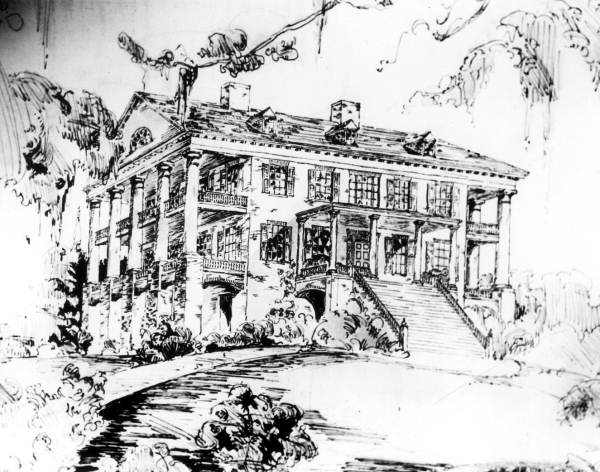Verdura Plantation on:
[Wikipedia]
[Google]
[Amazon]
 Verdura Plantation was a large forced-labor farm growing cotton on in eastern Leon County, Florida, United States established by
Verdura Plantation was a large forced-labor farm growing cotton on in eastern Leon County, Florida, United States established by
 Verdura Plantation was a large forced-labor farm growing cotton on in eastern Leon County, Florida, United States established by
Verdura Plantation was a large forced-labor farm growing cotton on in eastern Leon County, Florida, United States established by Benjamin Chaires
Benjamin Chaires Sr. (1786–1838) was an American planter, land owner, banker and investor in Territorial Florida, and may have been the richest man in Florida in the 1830s. He was involved in the creation of the first railroads in Florida.
...
.
History
Benjamin Chaires Sr. was an early arrival in Leon County and one of its wealthiest land owners. His brothers Green H. and Thomas P. establishedEvergreen Hills Plantation
Evergreen Hills Plantation was a large cotton plantation of 6700 acres (27 km2) located in eastern Leon County, Florida, United States established by Green H. Chaires.
Location
Evergreen Hills was located in 2 tracts. The first tract was bord ...
and Woodlawn Plantation, respectively, in Leon County.
Benjamin bought 10 miles east of Tallahassee
Tallahassee ( ) is the capital city of the U.S. state of Florida. It is the county seat and only incorporated municipality in Leon County. Tallahassee became the capital of Florida, then the Florida Territory, in 1824. In 2020, the population ...
in 1832 and built a brick plantation house
A plantation house is the main house of a plantation, often a substantial farmhouse, which often serves as a symbol for the plantation as a whole. Plantation houses in the Southern United States and in other areas are known as quite grand and e ...
in Greek Revival
The Greek Revival was an architectural movement which began in the middle of the 18th century but which particularly flourished in the late 18th and early 19th centuries, predominantly in northern Europe and the United States and Canada, but ...
style there. It had three floors and 15 rooms, each with a fireplace. Partitions downstairs could be removed to create an 80-foot long ballroom. Veranda
A veranda or verandah is a roofed, open-air gallery or porch, attached to the outside of a building. A veranda is often partly enclosed by a railing and frequently extends across the front and sides of the structure.
Although the form ''veran ...
s supported by Tuscan columns flanked it on it sides, rather than across the front. Its bricks were made handmade by forced labor on the plantation. The house stood on a hill partially surrounded by a stream. On a clear day the Gulf of Mexico was visible from the attic. It burned in 1885.
This was the nucleus of Chaires' holdings and he added to the plantation throughout the 1830s, including in 1836 when he added a forced-labor farm of 800 acres and 57 enslaved people to his holdings. He died in 1838 and tax records in 1839 show his estate to consist of and 80 enslaved humans. His son Joseph Chaires managed the plantation that year. The estate continued to grow after his death and in 1842, before it had been divided among his heirs, it foreclosed on land and yet more enslaved people valued at $35,570.
Chaires bequeathed the house, 500 acres surrounding it, and 10% of his personal property to his wife. Chaires had ten children, five of whom were minors, and in 1845 the county court authorized the division of the estate among them, including about , enslaved people, provisions, livestock, and equipment.
Each child's share of the Verdura plantation was still among the largest plantations in Leon County. While some planters were heavily in debt at their deaths, Chaires was not. His heirs continued to maintain large holdings and were not involved in lawsuits with banks over debts. The 1860 US Census recorded that 63 forced laborers at Verdura had produced 160 bales of cotton and of corn
Maize ( ; ''Zea mays'' subsp. ''mays'', from es, maíz after tnq, mahiz), also known as corn (North American and Australian English), is a cereal grain first domesticated by indigenous peoples in southern Mexico about 10,000 years ago. Th ...
. The loss of forced labor after the Civil War and a depression in the cotton market began its ruin. It was abandoned after the main house burned in 1885. It was sold by the Chaires family in 1948.
See also
*Plantations of Leon County, Florida
The plantations of Leon County were numerous and vast. Leon County, in the U.S. state of Florida, was a true cotton kingdom. From the 1820s through 1850s Leon County attracted cotton planters from Georgia, Virginia, Maryland, North and South Caro ...
* National Register of Historic Places listings in Leon County, Florida
Notes
References
* * * * * * {{Coord, 30.3811, -84.1659, display=title Plantations in Leon County, Florida Cotton plantations in Florida Burned houses in the United States